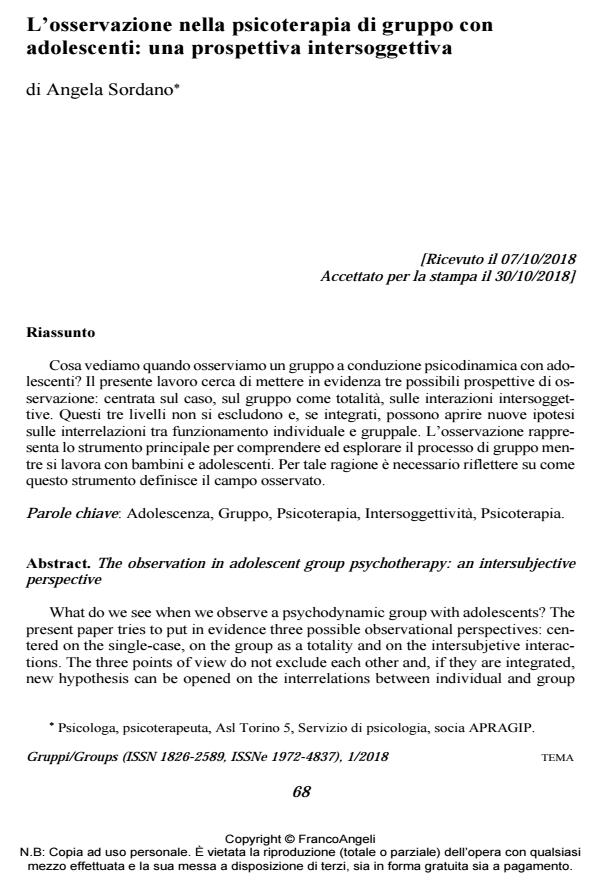The observation in adolescent group psychotherapy: an intersubjective perspective
Journal title GRUPPI
Author/s Angela Sordano
Publishing Year 2019 Issue 2018/1
Language Italian Pages 16 P. 68-83 File size 226 KB
DOI 10.3280/GRU2018-001005
DOI is like a bar code for intellectual property: to have more infomation
click here
Below, you can see the article first page
If you want to buy this article in PDF format, you can do it, following the instructions to buy download credits

FrancoAngeli is member of Publishers International Linking Association, Inc (PILA), a not-for-profit association which run the CrossRef service enabling links to and from online scholarly content.
What do we see when we observe a psychodynamic group with adolescents? The present paper tries to put in evidence three possible observational perspectives: centered on the single-case, on the group as a totality and on the intersubjetive interactions. The three points of view do not exclude each other and, if they are integrated, new hypothesis can be opened on the interrelations between individual and group functioning. The observation represents the main tool to understand and explore the group process while working with children and adolescents. For this reason it is necessary to reflect on how this tool defines the observed field.
Keywords: Adolescence, Group, Psychotherapy, Intersujectivity, Psychotherapy.
- Ahlin G. (1988). Reaching for the Group Matrix? Group Analysis, 21, 3: 211-226. DOI: 10.1177/053331648821300
- Benjamin J. (2018). Beyond Doer and Done to: Recognition Theory, Inter subjectivity and the Third. New York: Routledge.
- Berardelli S. (1990). La relazione osservativa. Napoli: Liguori.
- Burlingame G.M., McKenzie K.R. & Strauss B. (2004). Small Group Treatment: Evidence for Effectiveness and Mechanism of Change. In: Lambert M. (ed.). Handbook of Psychotherapy and Behaviour Change. V ed. New York: Wiley & Sons.
- Di Maria F. e Lo Verso G., a cura di (1995). La psicodinamica dei gruppi. Teorie e tecniche. Milano: Raffaello Cortina.
- Evans J. (1998). Psicoterapia analitica di gruppo per adolescenti. Roma: Borla, 2001.
- Fivaz-Depeursinge E. e Corboz-Warnery A. (1999). Il triangolo primario. Le prime interazioni triadiche tra padre, madre e bambino. Milano: Raffaello Cortina, 2000.
- Fivaz-Depeursinge E. e Phillipp D.A. (2014). Il bambino e la coppia. Milano: Raffaello Cortina, 2015.
- Fogel A., Garvey A., Hsu H. & West-Stroming D. (2006). Change Processes in Interpersonal Relationships: A Relational Historical Approach using Eraly Mother-infant communication. Cambridge: London Press.
- Foulkes S.H. (1975). La psicoterapia gruppoanalitica. Metodo e principi. Roma: Astrolabio, 1976.
- Foulkes S.H. e Anthony E.J. (1957). L’approccio psicoanalitico alla psicoterapia di gruppo. Roma: EUR, 1998.
- Gallese V. & Sinigallia C. (2010). The Bodily Self as Power for Action. Neuropsychologia, 48, 3: 746-755.
- Gallese V. & Sinigallia C. (2011). How the Body in Action Shapes the Self. Journal of Consciuosness Studies, 8, 7-8: 117-143.
- Gasca G. (2012). Lo psicodramma gruppoanalitico. Milano: Raffaello Cortina.
- Granovetter M. (1983). The Strength of Weak Ties: A Network Theory Revisited. Sociological Theory, 1: 201-233. DOI: 10.2307/202051
- Guarnaccia C., Molina P., Sala N. & Sordano A. (2017). “The GIPG: Psychometric Properties of a Grid for Interactive Patterns in Children and Adolescents Group Observation”. Relazione presentata alla VI Conferenza del network italiano per la ricerca empirica sui gruppi psicodinamici. Torino, 31 marzo-1 aprile.
- Harpaz-Rotem I. & Blatt S.J. (2009). A Pathway to Therapeutic Change: Changes in the Self-representation in the Treatment of Adolescents and Young Adults. Psychiatry. Interpersonal and Biological Processes, 72, 1: 32-49.
- Heider F. (1958). The Psychology of Interpersonal Relations. New York: Wiley & Sons. DOI: 10.1037/10628-000
- Jung C.G. (1976). Gli archetipi e l’inconscio collettivo. Torino: Bollati Boringhieri, 1980.
- Kroegel J., Burlingame G., Chapman C., Rensshaw T., Gleave R., Beecher M. & MacNair-Semands R. (2013). The Group Questionnare: a Clinical and Empirically Derived Measure of Group Relatonship. Psychotherapy Research, 23, 3: 344-354. DOI: 10.1080/10503307.2012.72986
- Lichtenberg J.D., Lachmann F.M. e Fosshage J.L. (1992). Il sé e i sistemi motivazionali. Verso una teoria della tecnica psicoanalitica. Roma: Astrolabio.
- Lo Coco G., Prestano C. e Lo Verso G. (2008). L’efficacia clinica delle psicoterapie di gruppo. Milano: Raffaello Cortina.
- Lys A. e Venuti P. (1996). L’osservazione nella psicologia dello sviluppo. Padova: Giunti.
- Mandelbrot B.B. (2001). Nel mondo dei frattali. Roma: Di Renzo.
- Meltzoff A.N. & Moore M.K. (1998). Infant Intersubjectivity: Broadeining the Dialogue to Include Imitation, Identity, Intention. In: Braten S., a cura di. Intersubjective Communication and Emotion in Early Ontogeny. Cambridge: London Press.
- Ogden T. (2008). L’arte della psicoanalisi. Sognare sogni non sognati. Milano: Raffaello Cortina.
- Popper K. (1935). Logica della scoperta scientifica. Torino: Einaudi, 1983.
- Scategni W. (1996). Psicodramma e terapia di gruppo. Spazio e tempo dell’anima. Como: Red.
- Sordano A. (2006). Fiaba, sogno e intersoggettività. Lo psicodramma analitico con bambini e adolescenti. Torino: Bollati Boringhieri.
- Stern D. (2004). Il momento presente: in psicoterapia e nella vita quotidiana. Milano: Raffaello Cortina, 2005.
- Trevarten C. (1979). Communication and Cooperation in Early Infancy: a Description of Primary Intersubjectivity. In: Bullowa M., a cura di. Before Speedch: the Beginning of Human Communication. London: Cambridge University Press.
- Tronick E.Z., Als H., Adamson L.B., Wise S. & Brazelton T.B. (1978). The Infant’s Response to Entrapment between Contradictory Message in Face-to-face Interaction. Journal of American Academy of Child Psychiatry, 17, 1: 1-13. DOI: 10.1016/S0002-7138(09)62273
- Winnicott D.W. (1965). Sviluppo affettivo e ambiente. Roma: Armando, 1970.
- Lo Sguardo simbolico nella relazione adulto-bambino-adolescente: una esperienza formativa online sui gruppi di psicodramma in età evolutiva Rosalena Cioli, Riccardo Garofalo, Simonetta Guarino, Irene Henche, Manuela Rocci, Concetta Romano, Roberta Russo, Sabrina Sanfilippo, Angela Sordano, in GRUPPI 2/2023 pp.51
DOI: 10.3280/gruoa2-2021oa15806
Angela Sordano, L’osservazione nella psicoterapia di gruppo con adolescenti: una prospettiva intersoggettiva in "GRUPPI" 1/2018, pp 68-83, DOI: 10.3280/GRU2018-001005